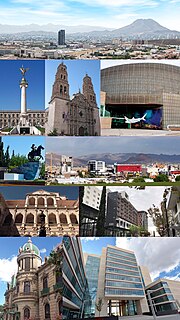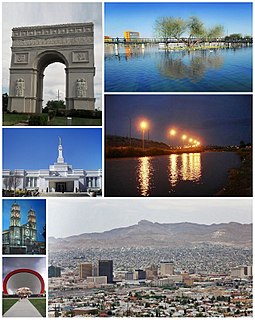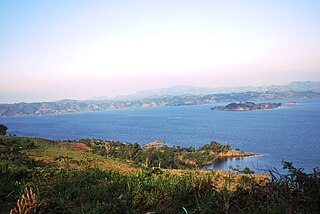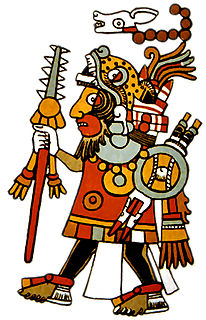 W
WAcapulco de Juárez, commonly called Acapulco, is a city and major seaport in the state of Guerrero on the Pacific coast of Mexico, 380 kilometres (240 mi) south of Mexico City. Acapulco is located on a deep, semicircular bay and has been a port since the early colonial period of Mexico's history. It is a port of call for shipping and cruise lines running between Panama and San Francisco, California, United States. The city of Acapulco is the largest in the state, far larger than the state capital Chilpancingo. Acapulco is also Mexico's largest beach and balneario resort city.
 W
WAguascalientes is the capital of the state of Aguascalientes and is its most populous city, with a metropolitan population of 1,225,432. It is one of the safest and most prosperous cities in Mexico. It is located in North-Central Mexico. It was part of the kingdom of Nueva Galicia. In 1835 Aguascalientes became the capital of the Free and Sovereign State of Aguascalientes. Aguascalientes has been called the cleanest city in Latin America. Aguascalientes is experiencing an ongoing social, economic, and aesthetic revitalization process. Aguascalientes has a population which includes Japanese, Koreans, Venezuelans, and Germans.
 W
WSan Francisco de Campeche, 19th c. English also Campeachy, is a city in Campeche Municipality in the state of Campeche, Mexico on the shore of the Bay of Campeche of the Gulf of Mexico. Both the seat of the municipality and the state's capital, the city had a population at the 2010 census of 220,389, and the municipality had a population of 259,005.
 W
WThe city of Chihuahua is the state capital of the Mexican state of Chihuahua. As of 2017, the city of Chihuahua had a population of 878,062 inhabitants. while the metropolitan area had a population of 1,036,806 inhabitants.
 W
WGuanajuato is a city and municipality in central Mexico and the capital of the state of the same name. It is part of the macroregion of the Bajío. It is in a narrow valley, which makes its streets narrow and winding. Most are alleys that cars cannot pass through, and some are long sets of stairs up the mountainsides. Many of the city's thoroughfares are partially or fully underground. The historic center has numerous small plazas and colonial-era mansions, churches, and civil constructions built using pink or green sandstone. The city historic center and the adjacent mines were proclaimed a World Heritage Site by UNESCO in 1988.
 W
WCiudad Juárez is the most populous city in the Mexican state of Chihuahua. The city is commonly referred to as simply Juárez, and was known as El Paso del Norte until 1888. Juárez is the seat of the Juárez Municipality with an estimated population of 1.5 million people. It lies on the Rio Grande river, south of El Paso, Texas, United States. Together with the surrounding areas, the cities form El Paso–Juárez, the second largest binational metropolitan area on the Mexico–U.S. border, with a combined population of over 2.7 million people.
 W
WLeón is the most populous city and municipality in the Mexican state of Guanajuato. In the 2015 Intercensal Survey INEGI reported 1,578,626 people living in the municipality of León, making it the fourth most populous municipality in Mexico. The metropolitan area of León recorded a population of 1,630,094 in the 2010 Census, making it the seventh most populous metropolitan area in Mexico. León is part of the macroregion of Bajío within the Central Mexican Plateau.
 W
WMérida is the capital and largest city in Yucatan state in Mexico, as well as the largest city of the Yucatán Peninsula. The city is located in the northwest part of the state, about 35 kilometres off the coast of the Gulf of Mexico. The city is also the municipal seat of the Municipality of Mérida, which includes the city and the areas around it.
 W
WPuebla, also known in Spanish as Puebla de Zaragoza, formally Heroica Puebla de Zaragoza and in colonial times as Puebla de los Ángeles, is the seat of Puebla Municipality, the capital and largest city of the state of Puebla, and the second largest in colonial Mexico and the richest Catholic diocese. A colonial era planned city, it is located in (southern) Central Mexico on the main route between the capital, Mexico City, and Mexico's main Atlantic port, Veracruz—about 100 km (62 mi) east southeast of Mexico City and about 220 km (140 mi) west of Veracruz.
 W
WQuechula is the name for a now-submerged village located in Chiapas, Mexico. The town was founded in the mid-1500s by Bartolomé de las Casas. The city was of strategic importance because it laid on the El Camino Real, a road that connected many important settlements in central Mexico, including Mérida and Campeche City. A large, grandiose church was constructed in the town due to the belief that the city would one day boast a large population. However, this never came to pass, and according to Carlos Navarrete, an architect who assisted with a report on the structure, it is unlikely the church ever had an official priest and it was probably served only by priests from other local dioceses.
 W
WTilantongo was a Mixtec citystate in the Mixteca Alta region of the modern-day state of Oaxaca which is now visible as an archeological site and a modern town of Santiago Tilantongo. It is located at 17°15' N. Lat. and 97°17' W. Long. Its Mixtec name was Ñuu Tnoo-Huahi Andehui meaning Black Town-Temple of Heaven